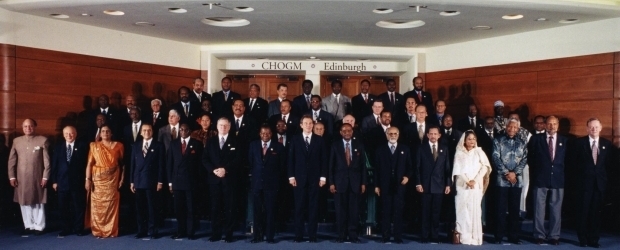 McKinnon: Mandela's "characteristics shone through in his dealings with the Commonwealth". [Commonwealth photo]
McKinnon: Mandela's "characteristics shone through in his dealings with the Commonwealth". [Commonwealth photo]
Abstract
The author, the fourth Secretary General of the Commonwealth and a former Foreign Minister of New Zealand, reflects on his encounters with Nelson Mandela. He sums up Mandela’s relationship with the Commonwealth in three phrases borrowed from Mandela’s biographer, Anthony Sampson: ‘a master of symbolic images’; determined ‘to lead from the front’; and when emerging from gaol as an overwhelming icon presented himself ‘as a fallible human being’. The author also considers New Zealand’s attitude to apartheid South Africa, and Mandela’s Commonwealth role after apartheid when, as South Africa’s new President, he made a powerful contribution to the development of the Commonwealth as a values-based association, upholding democracy and human rights.
Introduction
No one could ever have contact with Nelson Mandela, even if only for a fleeting moment, and forget the experience. Before you met him you knew who he was, what he stood for and what he had been through. The apartheid regime, the ANC and Robben Island were all part of Mandela’s epic, often tragic, but ultimately uplifting narrative. Consider how different the world would have been if the great man had died in the early days of his 27-year incarceration. We are all the better for Mandela’s long life, his sacrifices and his example. South Africa is certainly the better for Mandela even as it struggles to honour his legacy and aspirations for the nation.
I will not attempt in this brief article to try and emulate Mandela’s biographers—people such as Anthony Sampson, Fatima Meer or Mary Benson – all of whom examined his every action and dissected his every word. They and many others knew him better than I, and know more about him than I ever could.
The lasting impression I have from my experiences and discussions with Mandela can be summed up in three statements I will borrow from Sampson who said he was: ‘a master of symbolic images’; always determined to ‘lead from the front’; and, when emerging from gaol as an overwhelming global icon, was able to present himself ‘as a fallible human being’. All these characteristics shone through in his dealings with the Commonwealth. This of course was true in the long struggle against apartheid. But it was also the case after he finally emerged from 27 years of imprisonment and began to play his part in the world as the leader of his nation, but never being other than himself.



